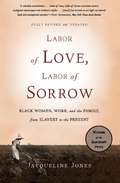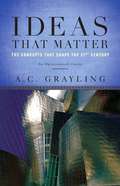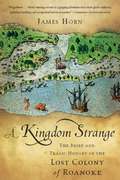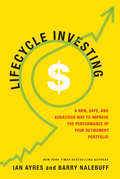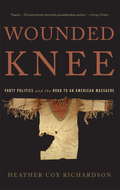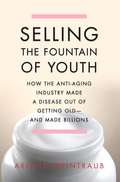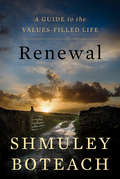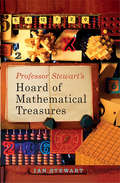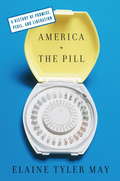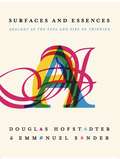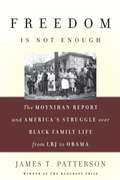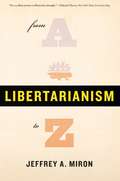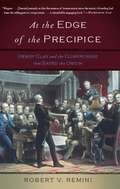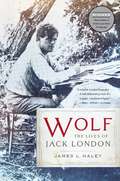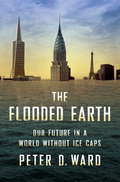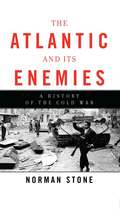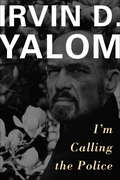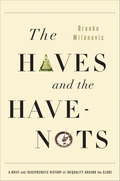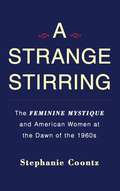- Table View
- List View
Labor of Love, Labor of Sorrow: Black Women, Work, and the Family, from Slavery to the Present
by Jacqueline JonesThe forces that shaped the institution of slavery in the American South endured, albeit in altered form, long after slavery was abolished. Toiling in sweltering Virginia tobacco factories or in the kitchens of white families in Chicago, black women felt a stultifying combination of racial discrimination and sexual prejudice. And yet, in their efforts to sustain family ties, they shared a common purpose with wives and mothers of all classes.In Labor of Love, Labor of Sorrow, historian Jacqueline Jones offers a powerful account of the changing role of black women, lending a voice to an unsung struggle from the depths of slavery to the ongoing fight for civil rights.
Labor of Love, Labor of Sorrow: Black Women, Work, and the Family, from Slavery to the Present
by Jacqueline JonesThe forces that shaped the institution of slavery in the American South endured, albeit in altered form, long after slavery was abolished. Toiling in sweltering Virginia tobacco factories or in the kitchens of white families in Chicago, black women felt a stultifying combination of racial discrimination and sexual prejudice. And yet, in their efforts to sustain family ties, they shared a common purpose with wives and mothers of all classes.In Labor of Love, Labor of Sorrow, historian Jacqueline Jones offers a powerful account of the changing role of black women, lending a voice to an unsung struggle from the depths of slavery to the ongoing fight for civil rights.
Ideas That Matter: The Concepts That Shape the 21st Century
by A. C. GraylingIdeas can, and do, change the world. Just as Marxism, existentialism, and feminism shaped the last century, so fundamentalism, globalization, and bioethics are transforming our world now. In Ideas that Matter, renowned philosopher A.C. Grayling provides a personal dictionary of the ideas that will shape our world in the decades to come. With customary wit, fire, and erudition, Grayling ranges across the gamut of essential theories, movements, and philosophies-from animal rights to neurophilosophy to war crimes-provoking and elucidating throughout.Ideas are the cogs that drive history, and in explaining the most complex and influential ones in laymen's terms, Ideas that Matter will help every engaged citizen better understand it.
A Kingdom Strange: The Brief and Tragic History of the Lost Colony of Roanoke
by James HornThe "gripping adventure story" (Christian Science Monitor) of the Lost Colony of Roanoke and the mystery at the center of the American foundingIn 1587, John White led 118 English men, women, and children to Roanoke Island, off the coast of North Carolina, intending to establish the first English colony in America. Faced with dwindling supplies and hostile Indians, they soon found themselves struggling to survive. White returned to England for help, but when he returned to Roanoke in 1590, the colonists were nowhere to be found; never saw his friends or family again. Their disappearance has remained a mystery for four centuries, but as James Horn reveals in A Kingdom Strange, some from the party survived. Their descendants were discovered a century later, a living testament to America's remarkable origins.
A Kingdom Strange: The Brief and Tragic History of the Lost Colony of Roanoke
by James HornIn 1587, John White and 117 men, women, and children landed off the coast of North Carolina on Roanoke Island, hoping to carve a colony from fearsome wilderness. A mere month later, facing quickly diminishing supplies and a fierce native population, White sailed back to England in desperation. He persuaded the wealthy Sir Walter Raleigh, the expedition's sponsor, to rescue the imperiled colonists, but by the time White returned with aid the colonists of Roanoke were nowhere to be found. He never saw his friends or family again. In this gripping account based on new archival material, colonial historian James Horn tells for the first time the complete story of what happened to the Roanoke colonists and their descendants. A compellingly original examination of one of the great unsolved mysteries of American history, A Kingdom Strange will be essential reading for anyone interested in our national origins.
Lifecycle Investing: A New, Safe, and Audacious Way to Improve the Performance of Your Retirement Portfolio
by Ian Ayres Barry NalebuffDiversification provides a well-known way of getting something close to a free lunch: by spreading money across different kinds of investments, investors can earn the same return with lower risk (or a much higher return for the same amount of risk). This strategy, introduced nearly fifty years ago, led to such strategies as index funds. What if we were all missing out on another free lunch that&’s right under our noses? In Lifecycle Investing, Barry Nalebuff and Ian Ayres—two of the most innovative thinkers in business, law, and economics—have developed tools that will allow nearly any investor to diversify their portfolios over time. By using leveraging when young—a controversial idea that sparked hate mail when the authors first floated it in the pages of Forbes—investors of all stripes, from those just starting to plan to those getting ready to retire, can substantially reduce overall risk while improving their returns. In Lifecycle Investing, readers will learnHow to figure out the level of exposure and leverage that&’s right for youHow the Lifecycle Investing strategy would have performed in the historical marketWhy it will work even if everyone does itWhen not to adopt the Lifecycle Investing strategy Clearly written and backed by rigorous research, Lifecycle Investing presents a simple but radical idea that will shake up how we think about retirement investing even as it provides a healthier nest egg in a nicely feathered nest.
Wounded Knee: Party Politics and the Road to an American Massacre (Great Plains Photography Ser.)
by Heather Cox RichardsonOn December 29, 1890, American troops opened fire with howitzers on hundreds of unarmed Lakota Sioux men, women, and children near Wounded Knee Creek in South Dakota, killing nearly 300 Sioux. As acclaimed historian Heather Cox Richardson shows in Wounded Knee, the massacre grew out of a set of political forces all too familiar to us today: fierce partisanship, heated political rhetoric, and an irresponsible, profit-driven media.Richardson tells a dramatically new story about the Wounded Knee massacre, revealing that its origins lay not in the West but in the corridors of political power back East. Politicians in Washington, Democrat and Republican alike, sought to set the stage for mass murder by exploiting an age-old political tool-fear. Assiduously researched and beautifully written, Wounded Knee will be the definitive account of an epochal American tragedy.
Wounded Knee: Party Politics and the Road to an American Massacre (Great Plains Photography Ser.)
by Heather Cox RichardsonOn December 29, 1890, American troops opened fire with howitzers on hundreds of unarmed Lakota Sioux men, women, and children near Wounded Knee Creek in South Dakota, killing nearly 300 Sioux. As acclaimed historian Heather Cox Richardson shows in Wounded Knee, the massacre grew out of a set of political forces all too familiar to us today: fierce partisanship, heated political rhetoric, and an irresponsible, profit-driven media. Richardson tells a dramatically new story about the Wounded Knee massacre, revealing that its origins lay not in the West but in the corridors of political power back East. Politicians in Washington, Democrat and Republican alike, sought to set the stage for mass murder by exploiting an age-old political tool -- fear. Assiduously researched and beautifully written, Wounded Knee will be the definitive account of an epochal American tragedy.
Selling the Fountain of Youth: How the Anti-Aging Industry Made a Disease Out of Getting Old-And Made Billions
by Arlene WeintraubThe beauty industry—which once revolved around creams and powders, subtle agents to enhance beauty—has become the anti-aging industry, overrun with steroids, human growth hormone injections, and &“bio-identical&” hormones—all promoted as &“cures&” for getting old. Acclaimed BusinessWeek science reporter Arlene Weintraub takes us inside this world, from the marketing departments of huge pharmaceutical companies to the backroom of your local pharmacy, from celebrity enthusiasts like Suzanne Somers and Oprah to the self-medicating doctors who run chains of rejuvenation centers, all claiming that we deserve to be forever young—and promising to show us how.Weintraub reveals the shady practices that run rampant when junk science and dubious marketing meet consumer choice. She shows for the remarkable economic and cultural impact of anti-aging medicine, on the patients who partake and on the rest of us. It&’s not a pretty story, but Weintraub tells us everything we need to know to avoid being duped by this billion-dollar—and dangerous—hoax.
Renewal: A Guide to the Values-Filled Life
by Shmuley BoteachOur culture is showing the cracks of a growing fracture. Soaring divorce rates; a crippled economy that rewards the few and punishes the many; religious-fueled hatred; record rates of depression—the headlines paint a grim picture. We inhabit a society that desperately needs fixing. But as Rabbi Shmuley Boteach reveals in his new book, Renewal, our society can made whole again when we as individuals make the choice to live a life based on values. For too long, conversations about values have been derailed by political movements trying to score points over hot-button issues like gay marriage or abortion. Boteach, one of our wisest and most respected counselors and spiritual experts, reaches deep into our history and into our shared religious legacy to revive the key universal values of Judaism for our struggling world. He presents these age-old ideas as guideposts for the challenges of modern times. These values, whose roots are in the Bible and thousands of years of Jewish spiritual living, can be applied to anyone in the modern world—from Christians and Muslims to atheists and agnostics—who want to renew their existence and recommit themselves to the most precious things in life. Renewal shows everyone how to use the timeless values of the Hebrew Bible and Judaism to live a more fulfilling, modern life.Destiny Unlike the Greeks, who believed that life was scripted from birth, the Jews believe in destiny. In short, they reject the idea of tragic fates and instead champion the individuals&’ capacity to create their own destiny through individual choice.Redemption Christians and Muslims emphasize salvation, or the need for man to become spiritual—to refine his character and earn a place in heaven. But Jews believe in world redemption, the capacity for the individuals to make heaven here on earth for,the betterment of the community.Action What you do is more important than what you believe. Good deeds always supersede good dogma.Enlightenment Jews are an infinitely curious people and believe that the great bane of existence—boredom—can only be cured by knowledge.Marriage Marriage refers not just to the institution, but rather the softening of the masculine by exposure to the feminine. A culture that does not know how to respect women is bound to collapse.Struggle It is wrestling with our nature, rather than attaining perfection, that constitutes true righteousness. Everyone is somehow flawed, but righteousness is found in the struggle to do right amid a predilection to act selfishly.Sacred Time Whereas other religions sanctify space, Jewish values privilege special moments. The Sabbath day, the holiest day of the week, provides a time for connecting with family and friends.
Professor Stewart's Hoard of Mathematical Treasures: Another Drawer From The Cabinet Of Curiosities
by Ian StewartOpening another drawer in his Cabinet of Curiosities, renowned mathematics professor Ian Stewart presents a new medley of games, paradoxes, and riddles in Professor Stewart's Hoard of Mathematical Treasures. With wit and aplomb, Stewart mingles casual puzzles with grander forays into ancient and modern mathematical thought.Amongst a host of arcane and astonishing facts about every kind of number from irrational and imaginary to complex and cuneiform, we learn: How to organize chaosHow matter balances anti-matterHow to turn a sphere inside out (without creasing it) How to calculate pi by observing the stars...and why you can't comb a hairy ball.Along the way Stewart offers the reader tantalizing glimpses of the mathematics underlying life and the universe. Mind-stretching, enlightening, and endlessly amusing, Professor Stewart's Hoard of Mathematical Treasures will stimulate, delight, and enthrall.
America and the Pill: A History of Promise, Peril, and Liberation
by Elaine Tyler MayIn 1960, the FDA approved the contraceptive commonly known as "the pill." Advocates, developers, and manufacturers believed that the convenient new drug would put an end to unwanted pregnancy, ensure happy marriages, and even eradicate poverty. But as renowned historian Elaine Tyler May reveals in America and the Pill, it was women who embraced it and created change. They used the pill to challenge the authority of doctors, pharmaceutical companies, and lawmakers. They demonstrated that the pill was about much more than family planning-it offered women control over their bodies and their lives. From little-known accounts of the early years to personal testimonies from young women today, May illuminates what the pill did and did not achieve during its half century on the market.
America and the Pill: A History of Promise, Peril, and Liberation
by Elaine Tyler MayIn 1960, the FDA approved the oral contraceptive that would come to be known as the pill. Within a few years, millions of women were using it. At a time when the population was surging, many believed that the drug would help eradicate poverty around the globe, ensure happy and stable marriages, and liberate women. In America and the Pill, preeminent social historian Elaine Tyler May reveals the ways in which the pill did and did not fulfill these utopian dreams, while also chronicling the stories of the creators, testers, and users who ultimately made the pill their own.
Surfaces and Essences: Analogy as the Fuel and Fire of Thinking
by Douglas Hofstadter Emmanuel SanderIs there one central mechanism upon which all human thinking rests? Cognitive scientists Douglas Hofstadter and Emmanuel Sander argue that there is. At this core is our incessant proclivity to take what we perceive, to abstract it, and to find resemblances to prior experiences—in other words, our ability to make analogies.In The Essence of Thought, Hofstadter and Sander show how analogy-making pervades our thought at all levels—indeed, that we make analogies not once a day or once an hour, but many times per second. Thus, analogy is the mechanism that, silently and hidden, chooses our words and phrases for us when we speak, frames how we understand the most banal everyday situation, guides us in unfamiliar situations, and gives rise to great acts of imagination.We categorize because of analogies that range from simple to subtle, and thus our categories, throughout our lives, expand and grow ever more fluid. Through examples galore and lively prose peppered, needless to say, with analogies large and small, Hofstadter and Sander offer us a new way of thinking about thinking.
Freedom Is Not Enough: The Moynihan Report and America's Struggle over Black Family Life--from LBJ to Obama
by James T. PattersonOn June 4, 1965, President Lyndon Johnson delivered what he and many others considered the greatest civil rights speech of his career. Proudly, Johnson hailed the new freedoms granted to African Americans due to the newly passed Civil Rights Act and Voting Rights Act, but noted that "freedom is not enough.” The next stage of the movement would be to secure racial equality "as a fact and a result.”The speech was drafted by an assistant secretary of labor by the name of Daniel Patrick Moynihan, who had just a few months earlier drafted a scorching report on the deterioration of the urban black family in America. When that report was leaked to the press a month after Johnson's speech, it created a whirlwind of controversy from which Johnson's civil rights initiatives would never recover. But Moynihan's arguments proved startlingly prescient, and established the terms of a debate about welfare policy that have endured for forty-five years.The history of one of the great missed opportunities in American history, Freedom Is Not Enough will be essential reading for anyone seeking to understand our nation's ongoing failure to address the tragedy of the black underclass.
Freedom Is Not Enough: The Moynihan Report and America's Struggle over Black Family Life -- from LBJ to Obama
by James T. PattersonOn June 4, 1965, President Lyndon Johnson delivered what he and many others considered the greatest civil rights speech of his career. Proudly, Johnson hailed the new freedoms granted to African Americans due to the newly passed Civil Rights Act and Voting Rights Act, but noted that "freedom is not enough." The next stage of the movement would be to secure racial equality "as a fact and a result." The speech was drafted by an assistant secretary of labor by the name of Daniel Patrick Moynihan, who had just a few months earlier drafted a scorching report on the deterioration of the urban black family in America. When that report was leaked to the press a month after Johnson's speech, it created a whirlwind of controversy from which Johnson's civil rights initiatives would never recover. But Moynihan's arguments proved startlingly prescient, and established the terms of a debate about welfare policy that have endured for forty-five years. The history of one of the great missed opportunities in American history, Freedom Is Not Enough will be essential reading for anyone seeking to understand our nation's ongoing failure to address the tragedy of the black underclass.
Libertarianism, from A to Z
by Jeffrey A. MironLibertarian principles seem basic enough—keep government out of boardrooms, bedrooms, and wallets, and let markets work the way they should. But what reasoning justifies those stances, and how can they be elucidated clearly and applied consistently? In Libertarianism, from A to Z, acclaimed Harvard economist Jeffrey Miron sets the record straight with a dictionary that takes the reader beyond the mere surface of libertarian thought to reveal the philosophy&’s underlying and compelling logic. Tackling subjects as diverse as prostitution and drugs, the financial crises and the government bailouts, the legality of abortion, and the War on Terror, Miron takes the reader on a tour of libertarian thought. He draws on consequentialist principles that balance the costs and benefits of any given government intervention, emphasizing personal liberty and free markets. Miron never flinches from following those principles to their logical and sometimes controversial ends. Along the way, readers get a charming and engaging lesson in how to think like a libertarian. Principled, surprising, and thought provoking, Libertarianism, from A to Z, has everything a bourgeoning libertarian—or any responsible citizen—needs to know.
At the Edge of the Precipice: Henry Clay and the Compromise That Saved the Union
by Robert V. ReminiIn 1850, America hovered on the brink of disunion. Tensions between slave-holders and abolitionists mounted, as the debate over slavery grew rancorous. An influx of new territory prompted Northern politicians to demand that new states remain free; in response, Southerners baldly threatened to secede from the Union. Only Henry Clay could keep the nation together.At the Edge of the Precipice is historian Robert V. Remini's fascinating recounting of the Compromise of 1850, a titanic act of political will that only a skillful statesman like Clay could broker. Although the Compromise would collapse ten years later, plunging the nation into civil war, Clay's victory in 1850 ultimately saved the Union by giving the North an extra decade to industrialize and prepare. A masterful narrative by an eminent historian, At the Edge of the Precipice also offers a timely reminder of the importance of bipartisanship in a bellicose age.
At the Edge of the Precipice: Henry Clay and the Compromise That Saved the Union
by Robert V. ReminiIn 1850, America hovered on the brink of disunion. Tensions between slave-holders and abolitionists mounted, as the debate over slavery grew rancorous. An influx of new territory prompted Northern politicians to demand that new states remain free; in response, Southerners baldly threatened to secede from the Union. Only Henry Clay could keep the nation together.At the Edge of the Precipice is historian Robert V. Remini's fascinating recounting of the Compromise of 1850, a titanic act of political will that only a skillful statesman like Clay could broker. Although the Compromise would collapse ten years later, plunging the nation into civil war, Clay's victory in 1850 ultimately saved the Union by giving the North an extra decade to industrialize and prepare. A masterful narrative by an eminent historian, At the Edge of the Precipice also offers a timely reminder of the importance of bipartisanship in a bellicose age.
Wolf: The Lives of Jack London
by James L. HaleyJack London was born a working-class, fatherless Californian in 1876. In his youth he was a boundlessly energetic adventurer on the bustling West Coast-by turns playing the role of hobo, sailor, prospector, and oyster pirate. He spent his brief life rapidly accumulating the experiences that would inform his acclaimed, best-selling books: The Call of the Wild, White Fang, and The Sea Wolf. London was plagued by contradictions. He chronicled nature at its most savage, but wept helplessly at the deaths of his favorite animals. At his peak the highest-paid writer in America, he was nevertheless constantly broke. An irrepressibly optimistic crusader for social justice, he burned himself out at forty: sick, angry, and disillusioned, but leaving behind a voluminous literary legacy, much of it ripe for rediscovery. In Wolf, award-winning author James L. Haley explores the forgotten Jack London-at once a hard-living globetrotter and a man alive with ideas, whose passion for social justice roared until the day he died. Returning London to his proper place in the American pantheon, Wolf resurrects a major American novelist in his full fire and glory.
The Flooded Earth: Our Future In a World Without Ice Caps
by Peter D. WardSea level rise will happen no matter what we do. Even if we stopped all carbon dioxide emissions today, the seas would rise one meter by 2050 and three meters by 2100. This-not drought, species extinction, or excessive heat waves-will be the most catastrophic effect of global warming. And it won't simply redraw our coastlines-agriculture, electrical and fiber optic systems, and shipping will be changed forever. As icebound regions melt, new sources of oil, gas, minerals, and arable land will be revealed, as will fierce geopolitical battles over who owns the rights to them.In The Flooded Earth, species extinction expert Peter Ward describes in intricate detail what our world will look like in 2050, 2100, 2300, and beyond-a blueprint for a foreseeable future. Ward also explains what politicians and policymakers around the world should be doing now to head off the worst consequences of an inevitable transformation.
The Atlantic and Its Enemies: A History of the Cold War
by Norman StoneAfter World War II, the former allies were saddled with a devastated world economy and traumatized populace. Soviet influence spread insidiously from nation to nation, and the Atlantic powers-the Americans, the British, and a small band of allies-were caught flat-footed by the coups, collapsing armies, and civil wars that sprung from all sides. The Cold War had begun in earnest.In The Atlantic and Its Enemies, prize-winning historian Norman Stone assesses the years between World War II and the collapse of the Iron Curtain. He vividly demonstrates that for every Atlantic success there seemed to be a dozen Communist or Third World triumphs. Then, suddenly and against all odds, the Atlantic won-economically, ideologically, and militarily-with astonishing speed and finality.An elegant and path-breaking history, The Atlantic and Its Enemies is a monument to the immense suffering and conflict of the twentieth century, and an illuminating exploration of how the Atlantic triumphed over its enemies at last.
I'm Calling the Police
by Irvin D. Yalom"Something heavy is going on ... the past is erupting ... my two lives, night and day, are joining. I need to talk." Irv Yalom's old medical school friend was making a plea for help. In their fifty years of friendship, Bob Berger had never divulged his nocturnal terrors to his close comrade. Now, finally, he found himself forced to.In I'm Calling the Police, Berger recounts to Yalom the anguish of a war-torn past: By pretending he was a Christian, Berger survived the Holocaust. But after a life defined by expiation and repression, a dangerous encounter has jarred loose the painful memory of those years. Together, they interpret the fragments of the horrific past that haunt his dreams.I'm Calling the Police is a powerful exploration of Yalom's most vital themes--memory, fear, love, and healing--and a glimpse into the life of the man himself.
The Haves and the Have-Nots: A Brief and Idiosyncratic History of Global Inequality
by Branko MilanovicWho is the richest person in the world, ever? Does where you were born affect how much money you&’ll earn over a lifetime? How would we know? Why—beyond the idle curiosity—do these questions even matter? In The Haves and the Have-Nots, Branko Milanovic, one of the world&’s leading experts on wealth, poverty, and the gap that separates them, explains these and other mysteries of how wealth is unevenly spread throughout our world, now and through time. Milanovic uses history, literature and stories straight out of today&’s newspapers, to discuss one of the major divisions in our social lives: between the haves and the have-nots. He reveals just how rich Elizabeth Bennet&’s suitor Mr. Darcy really was; how much Anna Karenina gained by falling in love; how wealthy ancient Romans compare to today&’s super-rich; where in Kenyan income distribution was Obama&’s grandfather; how we should think about Marxism in a modern world; and how location where one is born determines his wealth. He goes beyond mere entertainment to explain why inequality matters, how it damages our economics prospects, and how it can threaten the foundations of the social order that we take for granted. Bold, engaging, and illuminating, The Haves and the Have-Nots teaches us not only how to think about inequality, but why we should.
A Strange Stirring: The Feminine Mystique and American Women at the Dawn of the 1960s
by Stephanie CoontzIn 1963, Betty Friedan unleashed a storm of controversy with her bestselling book, The Feminine Mystique. Hundreds of women wrote to her to say that the book had transformed, even saved, their lives. Nearly half a century later, many women still recall where they were when they first read it.In A Strange Stirring, historian Stephanie Coontz examines the dawn of the 1960s, when the sexual revolution had barely begun, newspapers advertised for "perky, attractive gal typists,” but married women were told to stay home, and husbands controlled almost every aspect of family life. Based on exhaustive research and interviews, and challenging both conservative and liberal myths about Friedan, A Strange Stirring brilliantly illuminates how a generation of women came to realize that their dissatisfaction with domestic life didn't reflect their personal weakness but rather a social and political injustice.
